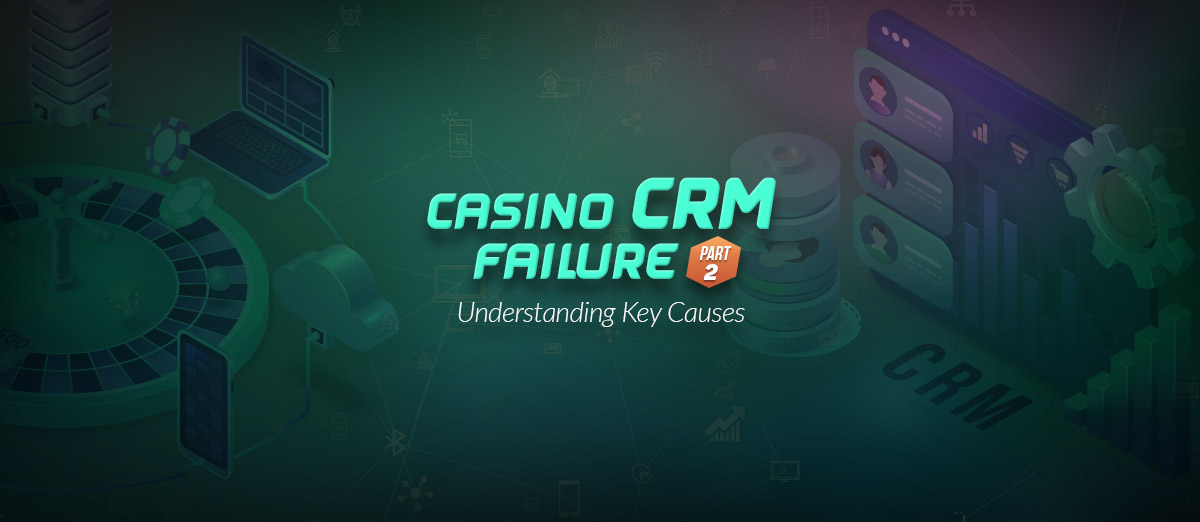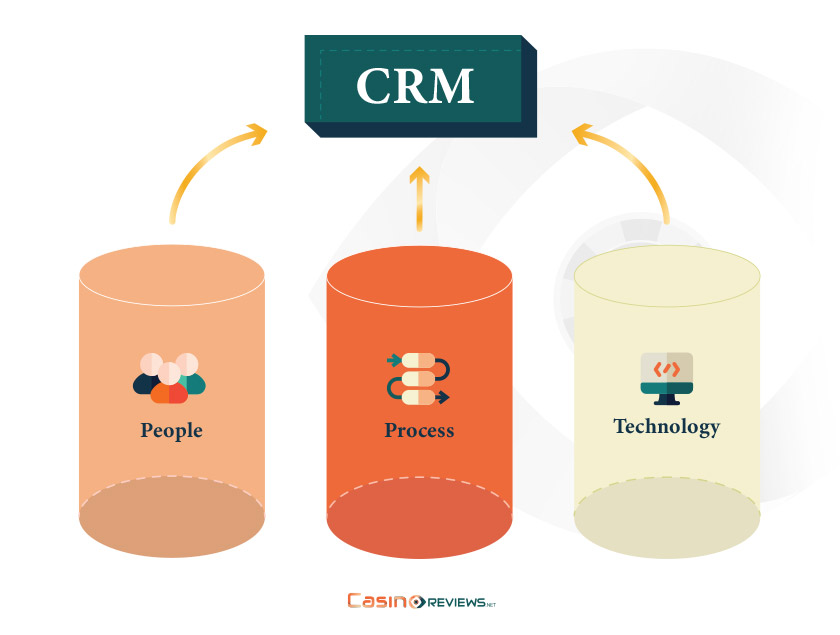Why Gaming Companies Are Losing the CRM Game: Part 2

Casino companies have been using CRM systems for almost twenty-five years, and one would expect a certain level of maturity in the application of this strategy/technology. As we indicated in Part 1 of our two-part series on CRM, the failure rate of CRM deployments is still unacceptably high. This installment on CRM failure looks at how five more factors contribute to CRM failure: Viewing CRM as technology, ignoring the ‘R’ in CRM, silo mentality in the organization, underestimating the change management effort, and inadequate business process re-engineering.
Introduction
Customer Relationship Management (CRM) can be viewed as “the philosophy, strategy, and process of optimally acquiring and retaining valued customers by providing them with consistent, seamless, high-quality experiences.” While over 90 percent of organizations with more than ten employees use some form of CRM, many business executives feel that CRM has not yielded the benefits that were expected.
There are several reasons why CRM falls short of expectations. In Part 1 of this CRM miniseries, we discussed five reasons why CRM fails: ill-defined scope, lack of CRM strategy, absence of customer-centric culture and practices, inadequate support from top management, and executives’ lack of understanding of customer lifetime value (CLV). We now look at five other major issues that prevent CRM from delivering the desired results.
Treating CRM as Technology
In most client meetings involving CRM, one of the first questions I am asked is, “What solution do you plan to deploy?” Even after three decades of implementation history, most businesses treat CRM as an IT initiative where you implement a few technology initiatives and: your customer retention will improve, your customer satisfaction score will increase, your optimal customer segmentation will simply happen, customer share of wallet will skyrocket, and your profitability will reach an all-time high.
Sure, technology plays a definite role in facilitating the management of customer relationships. Technology innovations in CRM systems enable collection and analysis of data on customer patterns, interpretation of customer behavior, development of predictive models, responding to customers with timely and effective customized communications, and delivering product and service value to individual customers. However, there exists a broad tendency among CRM users to overstate the role of technology.
In several studies on CRM failures, executives have repeatedly attributed only around five percent of failures to wrong technology. A postmortem of CRM disasters indicates that most failures occur due to people issues, not tech issues. It is people, not technology, who build relationships. It is the employees (your internal customers) who bring about customer retention, not technology. It’s the imagination of employees that creates compelling, personalized offers for customers, not technology.
That’s why, time and time again, we see superior people achieving quite outstanding results even with mediocre technology. Mediocre people invariably deliver mediocre results regardless of the technological superiority at hand.
When CRM is viewed as an IT initiative, an overwhelming amount of attention gets devoted to the technical features of the CRM system as opposed to devising the right strategies to harness these features. An IT-led CRM initiative becomes increasingly algorithm-driven and less and less customer needs-driven. The organization, over time, loses its capacity to deliver value to customers because of a lack of emphasis on the relational aspects of CRM.
The remarks of one expert, who I heard at a CRM conference way back in 2002, sum up beautifully the perils of treating CRM as a technology, “Hunting dogs can be thrown off a scent by dragging a pungent fish across their path. Just as easily, companies trying to understand their customers better can head off in the wrong direction because they have been distracted by the powerful technological capabilities of customer relationship management systems.”
Ignoring the ‘R’ in CRM
In applying CRM, most companies use the system to categorize customers into segments based on their current levels of profitability. “RFM” analysis helps marketers segment, market, and develop effective marketing strategies which maximize short-term ROI. In Handbook of Market Segmentation, Art Weinstein defines “recency as the last service encounter or transaction; frequency assesses how often these customer contact/company experiences occur; and monetary value probes the amount that is spent, invested, or committed by customers for the firm’s products and services.i”
While RFM is a powerful method of understanding customers’ current value, it focuses only on customers’ behavioral outcomes, not on their needs and emotions. Such analyses, based on economics and costs, provide little insight into why and in what ways people form relationships with companies and brands. Such a myopic view of customer relationships can prevent a firm from gaining a 360-degree view of its customers and using this understanding to enrich customer relationships for mutually rewarding outcomes over the entire duration of the relationship.
Fournier and Avery (2011) argue that CRM practice fails in three important ways when practitioners lose their focus on relationships, “First, companies seem to forget that their relationships are not just with consumers but with people: people who live rich and complicated lives. CRM programs rely on purchase information and do little to address deeper relational needs.“
„Second, because relationships come in different shapes and sizes, companies need to be cognizant of the requirements of diverse types of relationships beyond the loyalty ideal. Different relationships require different ways of relating, and managers must adapt their CRM programs accordingly. Finally, companies don’t recognize that relationships are two-sided and that these relationships evolve with each interaction. As much as managers like to claim credit for profitable relationships, they also need to be willing to look inward to learn why relationships break down.ii”
In their groundbreaking research, Fournier and Avery identify 18 different kinds of relationships based on seven dimensions: symbolic versus functional; strong versus weak; balanced versus one-sided; long term versus short term; independent versus interdependent; and voluntary versus constrained/imposed.
In the casino context, at least four of these 18 relationships are evident: addictions, fling, secret affair, and adversary. Not understanding the underlying dynamics of these four relationships results in the casino relating to all customers purely on the basis of theoretical win, thereby losing out on opportunities to further explore and enrich such relationships. A deeper understanding of each kind of relationship will also alert a casino as to which relationships to nurture and which ones to walk away from. While “flings” may be welcome and encouraged, “addictions” usually end up in depleted value and grief for both sides.
Understanding your customers and their emotional needs must be the first step in any relationship-building activity and must guide all downstream activities, including CRM. Otherwise, says Christopher Brya, former CEO of Solavista Consulting, “the offspring will consume the parent, and the brand will end up destroyed.iii”
Entrenched Silos
Silos may be a great way to store grain, but serious problems arise when a silo mentality runs unfettered in a company. Silo mentality is a mindset characterized by the unwillingness of certain departments, divisions, or sectors to share resources, including information, data, or expertise, with others in the same company. This type of mentality decreases efficiency in the overall operation, reduces employee morale, and often contributes to the demise of productive company culture.
A survey from the American Management Association conducted a few years ago showed that 83% of executives said that silos existed in their companies and that 97% thought they have a negative effect on the business.
An integrated casino resort typically has strong silos across key divisions such as F&B, Hotel, and Gaming. These silos usually form because of executives’ lack of understanding or appreciation of what the other departments or divisions do. Sometimes, there is underlying jealousy about the volume of contribution of a division to the company’s top line or bottom line.
There are also significant differences in the culture across divisions—Gaming often has a different culture from the Hotel division. Regardless of the reasons for silo formation, siloed divisions do not wholeheartedly contribute to each other’s success. A tell-tale sign of dysfunctional silos is the unwillingness to share data—especially unstructured customer data—across divisions.
Customer data are the backbone of CRM systems. It is on the basis of data that key decisions regarding market segmentation, customer lifetime value, and personalized customer offerings are made. When impermeable silos are pervasive within an organization, there is no possibility of creating a “single source of truth” within the organization. Single source of truth (SSOT) is a concept used to ensure that everyone in an organization bases business decisions on the same data. Without SSOT, decisions about customers are made inconsistently, erroneously, and capriciously.
It takes a lot of work to break down silos, or at least to create functional stovepipes between them. But such effort is necessary if the organization wants to reap the bountiful harvest of CRM.
Lowballing Change Management
CRM—done right—involves a radical departure from the configuration, the practices, the processes, and the organizational structure of a company. Extensive effort is therefore needed to enable people to deal with the changes wrought upon by CRM.
In addressing the human aspects of CRM projects, Daryl Conner observes, “When CRM is introduced in a work environment, it causes shock waves of disruption to emanate from the initial points of impact. These points of impact are the physical and political locations where the system is actually introduced and has its effects on the people it touches.iv” A key component of any CRM strategy, therefore, has to include comprehensive plans and procedures for effective change management.
Most executives underestimate the effort required in carrying out change management in order for CRM to succeed. A big part of change management involves “selling change” by top executives to the rank and file. Unfortunately, most senior executives hate to assume the role of a salesperson.
During change, prevailing cultural issues are the most likely ones to derail the project.
Salim Ismail, the author of Exponential Organizations, writes, “In the human body, the immune system fights millions of harmful pathogens so the body can function optimally. Like the body, organizations have immune systems too. The immune system of an organization naturally rises out of systems, procedures, and employee mindsets. It does its best to keep the system running smoothly by the status quo. But there are times when the organization’s immune system can become hyperactive. When this happens, it can’t tell the difference between an innovative opportunity and a perceived threat.v”
When you attempt disruptive change within an organization, according to Ismail, its immune system will attack you. Against all odds, top management needs to be unswerving in its zeal for change to create an organization-wide commitment to the CRM initiative. This involves prioritizing the CRM initiative and embarking upon a carefully engineered program of internal marketing of CRM.
Change is both an institutional voyage and a personal one. Individuals affected by the initiative need to be informed of how their work will change, what is expected of them during the various phases of change management, how their performance will be measured, and most importantly, what success and failure of the CRM program would spell for them and those around them. It is important to communicate to employees what the company is trying to achieve and why. A well-thought-out communications plan, clearly demonstrating the benefits of CRM to the organization and employees alike, will allow employees to appreciate the reasoning behind CRM and encourage adoption.
Business Process Reengineering
A business process is “a set of linked activities that create value by transforming an input into a more valuable output.vi” Business process re-engineering could be considered a part of change management. However, its significance in CRM programs calls for it being treated as a factor unto its own. Many organizations, particularly casinos, are all too eager to install CRM software but devote little thought to re-engineering or reconfiguration of their business processes.
The process constitutes one of the three pillars of the CRM edifice, the other two being people and technology. CRM technology allows businesses to gather intelligence which should inform business processes. Conversely, CRM strategy might dictate certain customer-centric processes for which analytical CRM would provide algorithms and insights.

Figure 1: The CRM Edifice
Process inputs and outputs can both be artifacts and/or information, and the transformation can be performed by human actors, machines, or both. Processes can be classified into three categories: management processes, operational processes, and support processes. Typical management processes include corporate governance and strategic management. In the case of casinos, managing risk and knowing your customer (KYC) would be important corporate governance processes. The current problems that Crown Resorts in Australia is facing exemplify what could go wrong when management processes are inadequate or absent.
Operational processes create the value stream and are therefore part of the core business. These include the casino’s operational processes, marketing, and sales. Prior to the inception of CRM, most casino hosts used a “black book” for storing important details on their customers. CRM now requires that key customer information be stored in the computer system along with predetermined data fields such as customer age, location, game preferences, and average daily theoretical (ADT). Doing so would require re-engineering the customer information storage process such that it provides valuable insights to the casino and meets customer privacy requirements.
Support processes are processes that facilitate core management and operational processes. Accounting processes, recruitment, and IT support would be good examples. The recruitment and training processes, for example, would need to be re-engineered if companies want to excel in their customer relationships. Croupiers and other floor personnel should be selected primarily on the basis of their aptitude to want to serve customers. Training of recruits should emphasize technical as well as customer satisfaction elements.
While most casinos in jurisdictions such as Macau and Cambodia have embraced CRM software, their recruitment and training processes have not changed to reflect the ”Relationship” aspect of CRM. Only humans can create relationships with humans. Casinos’ support processes used in recruitment and training should therefore underscore developing the relationship-building capabilities and emotional competencies of employees.
Key Takeaways
CRM has enormous potential to benefit both the operators as well as customers of casinos. Benefits for the customers include higher satisfaction and a superior guest experience that can be customized to their preferences. For the providers, CRM offers an array of benefits, including the ability to maximize customer lifetime value, build distinctive loyalty programs, develop effective customer segmentation, being able to make the right offer to the right customer at the right time, maximize share of customer wallet and thus increase revenues and profits across the entire customer lifecycle.
Unfortunately, ten common issues disrupt the attainment of these goals. This two-part series addressed these ten factors so that executives are sensitized to the damage each can inflict on Customer Relationship Management. CRM is not a matter of installing a piece of software. The software merely buys the users a seat at the table. Most effort toward making CRM a success needs to be devoted to the human elements that make-or-break CRM. An appreciation of the common causes of CRM failure and attending to them as a matter of urgency will go a long way toward reaping the full benefits CRM has to offer.
Read more:
iWeinstein, A. (2004). Handbook of Market Segmentation: Strategic Targeting for Business and Technology Firms, Third Edition, New York: Routledge.
iiFourner, Susan and Jill Avery (2011), “Putting the ‘Relationship’ Back Into CRM,” MIT Sloan Management Review, 52(3), 63-72.
iiiBrya, Christopher, "How CRM Can Destroy a Credit Union's Brand." Credit Union Journal, 24 June 2002, p. 4.
ivConner, Daryl (2001), “Managing the Human Aspects of CRM Projects: Installation vs. Realization,” ODR Whiter Paper.
vIsmail, Salim, “Is Your Corporate Immune System Killing Innovation and Hindering Growth?” (growthinstitute.com
viBibiano, Luis, Eric Mayol, and Joan Pastor (2007), “Role and Importance of Business Processes in the Implementation of CRM Systems,” 12th conference on software engineering and databases, Zaragoza (Spain), 56-62





Review this Blog
Leave a Comment
User Comments
comments for Why Gaming Companies Are Losing the CRM Game: Part 2